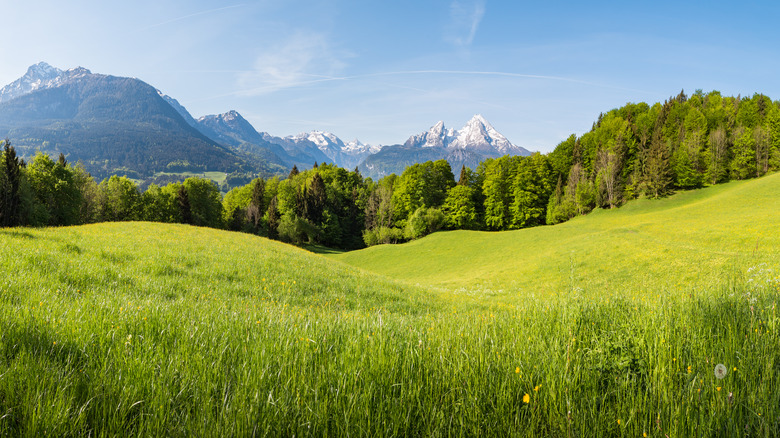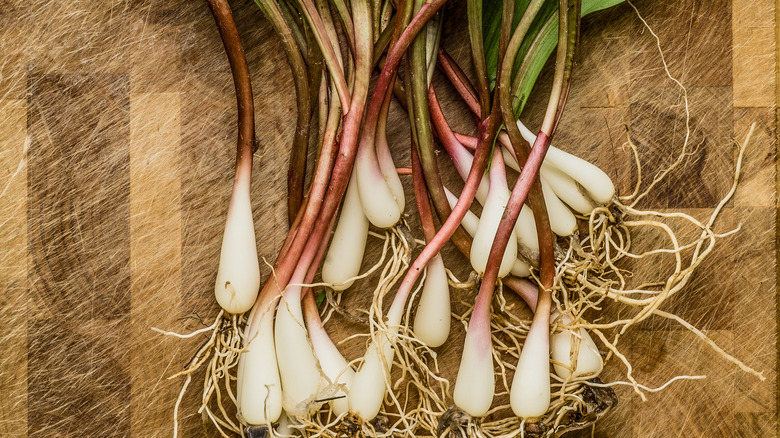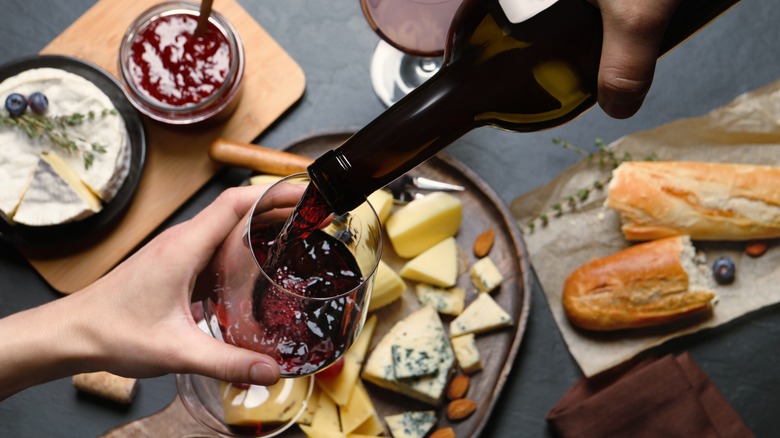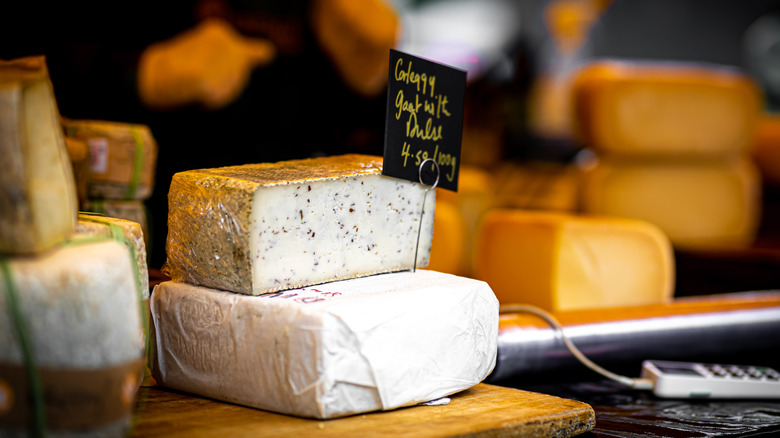Lisa With Ramps: The Flavorful Cheese With Notes Of Garlic And Onion
Surrounded by the cheesy powerhouses of France, Italy, Spain, and The Netherlands, Germany tends to be overlooked as a producer of quality cheese. The country nevertheless produces its original cheeses, some of which date back centuries. Made mostly by Trappist monks, German cheeses include the soft, dark-rinded Bruder Basil and Cambozola, a blue cheese with flavor that is said to be something between camembert and gorgonzola. And then you have Lisa with Ramps.
Despite its name sounding un-German compared to the other two, Lisa with Ramps is as German a cheese as you are likely to find. A more recent invention, Lisa with Ramps, comes from the mountainous state of Bavaria. The cheese is a beautiful example of taking nature's offerings and creating something delicious. For this cheese, wild, garlicky ramps of the Bavarian pastures are key to both production and flavor. Ramps are a common allium that grows throughout the United States, Canada, and Europe. They are a bounty from nature that coincide with the arrival of spring.
Lisa with Ramps, as you'll see, is made unique by the ingredients that go into it. Far from mass-produced, popular cheeses like cheddar or mozzarella, Lisa with Ramps is a specialty cheese with a flavor that will awaken the taste buds. Sound appetizing? It certainly should.
From the hills of Bavaria
Known for its rolling hills, beer, and fertile farmlands, Bavaria is Germany's top-producing cheese state. Over 70% of all German cheeses are produced in the Allgau region alone. Bavaria's pastures and woodlands also happen to be excellent for growing ramps (Allium tricoccum). Ramps can go by the names of wild leeks, spring onions, or wild garlic, and they typically grow in early spring. They are quite popular and sought after by foragers for their robust smell and flavor, similar to garlic.
As winter thaws into spring, the fields of Bavaria burst to life and team with ramps. The cows that graze these pastures ingest the leaves and bulbs of these spicy little plants. As a result, their milk takes on a mild oniony and garlicky taste. Cheesemaker Albert Kraus, the owner of Hofkäserei Kraus, noticed the flavor of the milk immediately and sought to take the flavor further. In the end, Kraus developed a cheese called Lisa with the addition of ramps — aka Lisa with Ramps (Rampe Kase).
The additional ramps blended perfectly with the body of the cheese since it was already mildly garlicky, thanks to the milk. Kraus had developed an excellent, versatile cheese that could lend itself well across many dishes and culinary uses.
How Lisa with Ramps is made
The chief ingredient in Lisa with Ramps is the milk from Brown Swiss cows that graze the Bavarian pastures. Originating from Switzerland, these cows are the second-largest cattle breed worldwide and can be found in over 60 countries. Their milk is prized by cheesemakers for its volume and excellent protein-to-fat ratio.
It's long been known that the quality of a cow's diet can change the nature of its milk. This is true with the Brown Swiss milk used to make Lisa with Ramps. As mentioned, these cows graze the fields in early spring, ingesting the natural grasses and wild ramps, giving their milk a mild tone of onions and garlic. The rennet used to turn the unpasteurized milk into cheese comes from the lining of the cow's stomach. Salt, cultures, and more ramps are added once the curd is separated from the whey. The cheese is then set in a mold, washed to form a rind, and set to age for three months.
The resulting cheese looks relatively unremarkable. Its rind has a white-orange hue, flecked with specks of green. Made in thirteen-pound wheels, the aged cheese can be sliced according to customer fancy. However, once tasted, there is absolutely nothing unremarkable about Lisa with Ramps.
What does Lisa with Ramps taste like?
The flavor of ramps immediately hits upon biting into a slice of Lisa with Ramps. Ramps, like their cousin scallion, have leafy green shoots and white, bulbous bottoms that deliver a cross-between onion and garlic flavors. Since the whole of the ramp is used in Lisa with Ramps, you get the benefit of both the onions and the garlic, neither of which is too intense once mixed with the dairy. Since the cheese is aged for such a short period, the ramps get just enough time to impart flavor but not so much time that they'll take over completely.
The cheese itself is actually soft, though it has been noted as having a slight spring to it. Other flavors at play include the delicious creaminess from the excellent milk of the Brown Swiss cow. The hint of pasture is there, too, giving off a subtle grassy and nutty taste that is hidden at first by the presence of the ramps — but it slowly reveals itself as you chew. The more the cheese lingers on the palate, the more its complexities are revealed. Unlike blue cheese or gorgonzola, which smack you over the head with its intense flavors, Lisa with Ramps allows you to take your time and savor each individual flavor.
Food and drink pairings
Thanks to its soft texture and savory flavors, Lisa with Ramps makes for excellent grilled cheese. Add a slice of grilled bacon to that, and we can guarantee you'll never want to eat any other sandwich. Lisa with Ramps is also great on its own or paired with fellow cheeses and meats on a charcuterie board. The garlic and onion notes will pair extremely well with sweeter fruits like apricots and grapes and provide the salty cured meats with wonderful sub-notes of cream and garlic.
Lisa with Ramps can easily be spread across toast or a nice slice of dark rye bread. You could toss it into a salad with a peppery pairing like arugula or escarole, maybe throwing in some chopped almonds and a raspberry vinaigrette to add a little sweetness to combat the savory nature of the salad.
Strong-bodied red wines, like a Petite Sirah, with its deep flavors of sugarplum, dark chocolate blueberry, and black pepper, make a truly excellent accompaniment to this springy German cheese. A bold Chardonnay works well, too. However, as the cheese is of Bavarian origin, you would do well to pair it with a nice German beer. Pick one from Bavaria, like a pale and crisp Helles or darker, more earthy Dunkels. Either will do the trick, as Lisa with Ramps is an incredibly versatile cheese that goes with everything from roasted meat to crackers. There really is no way to go wrong here.
Where to buy Lisa with Ramps
As hungry as you are by now, we've got to admit that you may have a hard time tracking down a wedge of Lisa with Ramps for your next grilled cheese craving. This is not a cheese you're likely to find at your local grocery store, even one stocked with specialty cheeses like Whole Foods. This is not to say that they will never stock it — just don't count on it.
The place you are most likely to find Lisa with Ramps is a specialty food shop. Unlike supermarkets, specialty food shops trend toward a more limited, higher-quality inventory. Most will have staff on hand who have knowledge of a specific specialty — in this case, the cheesemonger is who you want to talk to about Lisa with Ramps. Any good cheesemonger will have some on hand, and if not, place an order for you. They'll also be able to explain more pairing options.
Of course, there is the ability to purchase online, which is probably the best option if you don't live in an area that sports a specialty food shop. St. James Cheese Company, Cured and Cultivated, Fresh Direct, and Balducci's each carry Lisa with Ramps in various quantities. Be sure to keep an eye out for when it's in stock because this Bavarian product tends to sell out rather quickly. If you do get your hands on some, rejoice — you're in for a wonderful cheesy treat.





